No offense to any pink bunny mascots out there, banging on a drum to prove how long-lasting their product is, but most of the batteries everyone is interested in these days can’t be bought at a supermarket.
Instead, the focus is on batteries that power our phones, computers, electric vehicles and electrical grids, all of which have seen massive design and technological changes in recent years. More changes will work their way into our daily lives too, since corporate and government sectors are signaling ambitious battery-based goals in the immediate future. The Biden presidential campaign promised to “leverage the breakthroughs we have secured in energy storage over the last decade” when modifying the energy grid, and General Motors announced plans to only sell zero-emission vehicles by 2035.

